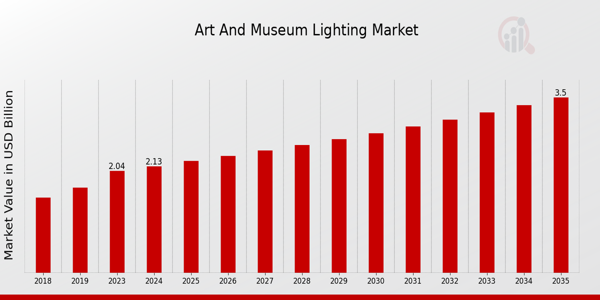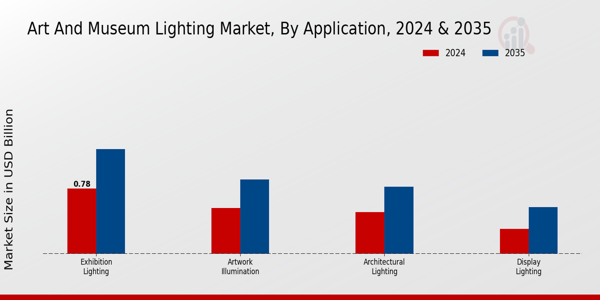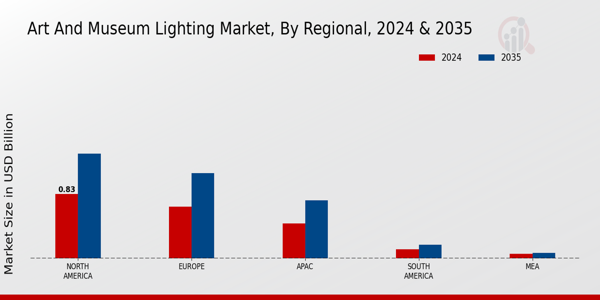Art and Museum Lighting Market Overview:
As per MRFR analysis, the Art and Museum Lighting Market Size was estimated at 2.04 (USD Billion) in 2023. The Art and Museum Lighting Market Industry is expected to grow from 2.13(USD Billion) in 2024 to 3.5 (USD Billion) by 2035.
The Art and Museum Lighting Market CAGR (growth rate) is expected to be around 4.62% during the forecast period (2025 - 2035).
Key Art and Museum Lighting Market Trends Highlighted
The Global Art and Museum Lighting Market is experiencing notable growth due to several key drivers. The increasing focus on enhancing visitor experiences through innovative lighting solutions is paving the way for advancements in art illumination technologies. Technologies like LED lighting offer energy efficiency and versatility, which are highly sought after for showcasing artworks without causing damage. Additionally, the growing number of museums and art galleries worldwide is fueling demand for specialized lighting systems designed to meet the distinct requirements of various art forms and exhibitions. Opportunities in the market can be found in the rising interest in smart, customizable lighting systems.With ongoing developments in automation and smart technology, art institutions have the chance to leverage these innovations to create immersive and dynamic environments. Integrating these systems allows for tailored lighting experiences that adapt to different exhibitions, enhancing how art is perceived. Furthermore, the ongoing emphasis on sustainability provides avenues for companies to develop eco-friendly lighting solutions that align with modern institutional values. Recent trends indicate a shift towards the use of tunable white and color-changing LED lighting, enabling museums to adjust lighting conditions for different types of artworks and media.There is also a growing interest in utilizing lighting as part of the art installation itself, where light becomes a medium, complementing the art rather than merely illuminating it. The evolution towards more artistic and functional lighting designs reflects a broader trend toward experiential engagement in museum spaces, emphasizing the role of lighting in storytelling and curatorial strategies.

Source: Primary Research, Secondary Research, MRFR Database and Analyst Review
Art and Museum Lighting Market Drivers
Increasing Importance of Art Preservation and Conservation
As cultural institutions continue to acknowledge the importance of preserving and showcasing art, the demand for specialized lighting solutions in the Global Art and Museum Lighting Market Industry has risen significantly. Effective lighting is essential not only for the aesthetic presentation of artworks but also for their preservation. Museums are increasingly investing in advanced lighting technologies that minimize the degradation of artworks caused by ultraviolet (UV) and infrared (IR) radiation.This shift towards conservation-minded practices has driven innovation in lighting design, encouraging the incorporation of LED technology which produces less heat and UV, thus lowering the risk of damage to sensitive materials. Additionally, educational initiatives aimed at highlighting the role of proper lighting in art conservation have created a heightened awareness among curators and museums, leading to increased budgeting for quality lighting solutions.Many organizations now recognize that poor lighting can not only harm the integrity of artworks but also detract from the visitor experience, making investment in quality art lighting a priority. The continued focus on enhancing visitor engagement through well-designed exhibit lighting has further expanded the scope of the Global Art and Museum Lighting Market Industry. As the value of art becomes more pronounced and as institutions seek to attract greater attendance, the willingness to invest in optimal lighting solutions will directly contribute to market growth.A robust demand for artistic and museum lighting systems as well as specific market opportunities is growing due to technological improvements alongside a changing culture regarding conservation.
Technological Advancements in Lighting Solutions
The Global Art and Museum Lighting Market Industry is benefiting from rapid advancements in lighting technology. Innovations such as smart lighting systems, enhanced LED technology, and automated control systems are revolutionizing how artworks are illuminated in exhibitions. These technological developments allow museums to fine-tune lighting settings to highlight specific pieces while considering the safety of the materials. Enhanced energy efficiency offered by modern lighting solutions is also contributing to lower operational costs, making it an attractive option for many institutions looking to reduce expenses without compromising on quality.As these technologies continue to evolve, they provide more adaptive and dynamic lighting options that can dramatically improve the overall visitor experience at exhibitions.
Rising Number of Art Exhibitions and Museums
The growth in the number of art exhibitions and museums around the world serves as a significant driver for the Global Art and Museum Lighting Market Industry. With increasing interest in cultural exploration and appreciation, new galleries and museums are frequently emerging, necessitating tailored lighting solutions that accommodate the unique requirements of each venue. This augmentation in the art sector fosters a robust demand for specialized lighting that can enhance the presentation of various artworks, thereby further propelling the market.
Art and Museum Lighting Market Segment Insights:
Art and Museum Lighting Market Application Insights
The Global Art and Museum Lighting Market revenue is projected to reach significant values, with a valuation of 2.13 USD Billion in 2024 and expected to grow further to 3.5 USD Billion by 2035, reflecting a steady demand in the sector. Within this market, the segmentation around applications reveals critical insights, where Exhibition Lighting holds a majority share, valued at 0.78 USD Billion in 2024 and projected to reach 1.25 USD Billion in 2035. This segment is essential as it directly enhances the visual appeal of exhibits, drawing audience attention and fostering engagement.Following closely, Artwork Illumination, starting at 0.55 USD Billion in 2024 and rising to 0.89 USD Billion in 2035, plays a significant role in ensuring the preservation and display of artistic pieces, catering to the need for high-quality lighting for artworks influences visitor experiences dramatically. Architectural Lighting, valued at 0.5 USD Billion in 2024 and expected to grow to 0.8 USD Billion by 2035, emphasizes the aesthetics and functionality of museum spaces, contributing to the overall ambiance and guest navigation while also establishing a creative identity for institutions.Finally, Display Lighting currently sits at 0.3 USD Billion in 2024, with growth to 0.56 USD Billion anticipated by 2035, serving as a foundational element that accentuates specific products or installations within museums, although it is the least dominant in the market. The Global Art and Museum Lighting Market segmentation thus demonstrates diverse applications that collectively drive market growth, with each category playing its unique role in enhancing the visitor experience while addressing the technical demands of art preservation and display.The interrelationship between these application types creates opportunities for technological advancements, offering solutions that balance artistic integrity with operational efficiency, thereby shaping the future landscape of the art and museum lighting sector.

Source: Primary Research, Secondary Research, MRFR Database and Analyst Review
Art and Museum Lighting Market Technology Insights
This market covers various technologies, including LED Lighting, Halogen Lighting, Fluorescent Lighting, and Incandescent Lighting, with LED Lighting being a prominent choice due to its energy efficiency and longevity, making it vital for art preservation. Halogen Lighting is favored for its color rendering capabilities, providing vibrant illumination for artworks. Fluorescent Lighting is recognized for its cost-effectiveness, while Incandescent Lighting, despite being less efficient, retains aesthetic qualities that some museums prefer for specific displays.The demand for these lighting technologies is driven by the need for sustainable solutions and improved art presentation, presenting opportunities for innovation. The market's potential continues to grow as institutions invest in advanced lighting technologies to enhance visitor experiences and protect valuable art collections. The overall market dynamics showcase a trend toward integrated solutions that address both artistic and conservation needs, facilitating diverse applications across the global art and museum landscape.
Art and Museum Lighting Market End Use Insights
This segment encompasses various applications including art galleries, museums, historical sites and cultural centers, each holding distinct significance. Art galleries frequently demand specialized lighting to enhance artwork visibility and preserve colors, making them a critical portion of the market. Museums utilize advanced lighting solutions not only to showcase their collections but also to create immersive experiences, which has made them a significant player in the market.Historical sites rely on proper lighting to maintain their integrity while also attracting visitors, underscoring the importance of careful illumination. Cultural centers benefit from versatile lighting options that cater to various exhibitions and events, making them dominant in the market's landscape. These segments collectively influence the Global Art and Museum Lighting Market revenue, reflecting the crucial function that tailored lighting solutions hold in enhancing the display and preservation of art and heritage. Market trends indicate a growing emphasis on energy-efficient lighting, thereby opening opportunities for innovation and growth in segment-specific solutions.As the industry expands, challenges such as balancing aesthetic needs with energy consumption will need addressing.
Art and Museum Lighting Market Brightness Level Insights
This market encompasses various brightness levels, catering to the distinct needs for illuminating art and museum exhibits. High Brightness options are crucial for effectively showcasing intricate details and vibrant colors in artwork, often preferred in environments where natural light is limited. Medium Brightness solutions serve as a versatile choice for general display purposes while ensuring that artworks are enhanced without causing potential damage.Low Brightness segments, although smaller in share, are important for displaying sensitive materials that require gentle illumination. Together, these brightness levels highlight the diverse requirements of the art and museum lighting sector. The market growth can be attributed to increasing investments in art preservation and display technologies, as well as a growing awareness of the importance of proper lighting in enhancing visitor experience. Furthermore, the Global Art and Museum Lighting Market data suggests an evolving trend towards energy-efficient lighting solutions, presenting opportunities for innovation within the industry.Market statistics reflect an ongoing demand for tailored solutions that balance aesthetic appeal and preservation needs.
Art and Museum Lighting Market Regional Insights
The Global Art and Museum Lighting Market revenue exhibits notable regional diversity, with North America leading the charge, valued at 0.83 USD Billion in 2024, and is projected to reach 1.35 USD Billion by 2035, demonstrating its significant demand for innovative lighting solutions. Europe follows closely, with a market valuation of 0.67 USD Billion in 2024, expected to grow to 1.1 USD Billion by 2035, indicating a robust cultural commitment to enhancing art experiences. The APAC region, valued at 0.45 USD Billion in 2024, is also witnessing growth, reaching 0.75 USD Billion by 2035, driven by increasing investments in cultural institutions and museums.Meanwhile, South America and MEA are smaller markets, with valuations of 0.12 USD Billion and 0.06 USD Billion in 2024, rising to 0.18 USD Billion and 0.07 USD Billion, respectively, by 2035, reflecting emerging interest in art preservation and exhibition. Together, these regions contribute to the Global Art and Museum Lighting Market segmentation, showcasing diverse opportunities driven by cultural relevance and technological advancements in lighting solutions, essential for enhancing the visual impact of art displays effectively.

Source: Primary Research, Secondary Research, MRFR Database and Analyst Review
Art and Museum Lighting Market Key Players and Competitive Insights:
The Global Art and Museum Lighting Market has seen significant evolution in recent years, driven by the increasing appreciation for art and the need to preserve it through specialized lighting solutions. As exhibitions and galleries push for more advanced technology to showcase artworks while ensuring their safety and longevity, the competitive landscape is becoming increasingly dynamic. Factors such as innovation in lighting technology, sustainability practices, and personal experience enhancements are critical components that companies are leveraging to assert their dominance in this market. As various stakeholders, including art curators, exhibit designers, and museum administrators, seek optimal lighting solutions, it leads to heightened competition and a differentiated market presence among key players.Lutron Electronics is a leading force in the Global Art and Museum Lighting Market, distinguished by its innovative, energy-efficient lighting solutions specifically designed for art spaces. The company’s product lineup is characterized by advanced control systems that enable precise customization of illumination, ensuring that artworks are presented to their best advantage.
Lutron Electronics focuses on creating an ambiance that not only preserves the integrity of the artwork but also enhances the viewer's experience. The company's dedication to sustainability and energy efficiency aligns with the growing trend among museums to reduce carbon footprints while maintaining high lighting standards. Lutron’s strong emphasis on research and development allows it to consistently introduce cutting-edge technology, which places it at the forefront of this specialized market.Crestron also holds a significant position in the Global Art and Museum Lighting Market, offering integrated solutions that simplify the management and control of complex lighting scenarios in art venues. Known for its powerful automation and control systems, Crestron enables museums and galleries to achieve dynamic lighting setups that can adapt to different exhibitions and events with ease. The versatility of Crestron’s technology supports various lighting types, including LED and incandescent, allowing museums to tailor their lighting according to the specific needs of their collections. Additionally, Crestron’s user-friendly interfaces and robust support services enhance its appeal to art institutions, ensuring that they can effectively manage their lighting systems for both current and future needs. The company’s commitment to enhancing the overall visitor experience through smart technology reinforces its position within this competitive landscape, making it a trusted partner for many in the art and museum sector.
Key Companies in the Art and Museum Lighting Market Include:
- Lutron Electronics
- Crestron
- Maxim Lighting
- Eaton
- Schneider Electric
- Acuity Brands
- Osram
- Fagerhult
- Lightology
- RAB Lighting
- iGuzzini
- Zumtobel Group
- Philips
- Delta Light
- GE Lighting
Art and Museum Lighting Market Industry Developments
The Global Art and Museum Lighting Market has recently experienced significant developments, with a focus on innovative lighting solutions that enhance the presentation of artworks while ensuring their preservation. Companies such as Lutron Electronics and Acuity Brands are advancing technologies that integrate smart lighting controls, improving energy efficiency and user control in museum exhibits. There is a growing trend toward sustainable lighting practices, with organizations like Philips and Osram investing in LED technologies that are both eco-friendly and cost-effective. In terms of mergers and acquisitions, the market has seen strategic alignments aimed at expanding product portfolios and technological capabilities, although specific recent mergers within the specified companies remain limited.
Eaton and Schneider Electric continue to explore partnerships to combine their expertise in building management systems with art and museum lighting solutions. The market's valuation has shown positive growth, driven by rising investments in cultural institutions and a strategic pivot toward enhancing visitor experiences through advanced lighting systems, indicating a robust demand for specialized lighting products and services from companies such as GE Lighting, Fagerhult, and Lightology.
Art and Museum Lighting Market Segmentation Insights
-
Art and Museum Lighting Market Application Outlook
-
Exhibition Lighting
-
Artwork Illumination
-
Architectural Lighting
-
Display Lighting
-
Art and Museum Lighting Market Technology Outlook
-
LED Lighting
-
Halogen Lighting
-
Fluorescent Lighting
-
Incandescent Lighting
-
Art and Museum Lighting Market End Use Outlook
-
Art Galleries
-
Museums
-
Historical Sites
-
Cultural Centers
-
Art and Museum Lighting Market Brightness Level Outlook
-
High Brightness
-
Medium Brightness
-
Low Brightness
-
Art and Museum Lighting Market Regional Outlook
-
North America
-
Europe
-
South America
-
Asia Pacific
-
Middle East and Africa
| Attribute/Metric Source: |
Details |
| MARKET SIZE 2023 |
2.04(USD Billion) |
| MARKET SIZE 2024 |
2.13(USD Billion) |
| MARKET SIZE 2035 |
3.5(USD Billion) |
| COMPOUND ANNUAL GROWTH RATE (CAGR) |
4.62% (2025 - 2035) |
| REPORT COVERAGE |
Revenue Forecast, Competitive Landscape, Growth Factors, and Trends |
| BASE YEAR |
2024 |
| MARKET FORECAST PERIOD |
2025 - 2035 |
| HISTORICAL DATA |
2019 - 2024 |
| MARKET FORECAST UNITS |
USD Billion |
| KEY COMPANIES PROFILED |
Lutron Electronics, Crestron, Maxim Lighting, Eaton, Schneider Electric, Acuity Brands, Osram, Fagerhult, Lightology, RAB Lighting, iGuzzini, Zumtobel Group, Philips, Delta Light, GE Lighting |
| SEGMENTS COVERED |
Application, Technology, End Use, Brightness Level, Regional |
| KEY MARKET OPPORTUNITIES |
Smart lighting technology integration, Energy-efficient lighting solutions, Customizable lighting systems, Enhanced visitor experience design, Sustainable lighting materials usage |
| KEY MARKET DYNAMICS |
Technological advancements in lighting, Increasing focus on preservation standards, Growing tourism and cultural interest, Shift towards energy-efficient solutions, Rising integration of smart technologies |
| COUNTRIES COVERED |
North America, Europe, APAC, South America, MEA |
Frequently Asked Questions (FAQ) :
The Global Art and Museum Lighting Market is expected to be valued at 2.13 USD Billion in 2024.
By 2035, the Global Art and Museum Lighting Market is projected to reach a value of 3.5 USD Billion.
The anticipated CAGR for the Global Art and Museum Lighting Market between 2025 and 2035 is 4.62%.
North America is expected to dominate the Global Art and Museum Lighting Market with a projected value of 1.35 USD Billion by 2035.
Exhibition Lighting is valued at 0.78 USD Billion in 2024 within the Global Art and Museum Lighting Market.
The Artwork Illumination segment is projected to be valued at 0.89 USD Billion by 2035.
Key players include Lutron Electronics, Crestron, Maxim Lighting, Eaton, Schneider Electric, and Acuity Brands.
The market size for Display Lighting is expected to reach 0.56 USD Billion by 2035.
The Middle East and Africa (MEA) has the smallest market size at 0.06 USD Billion in 2024.
The Architectural Lighting segment is projected to reach 0.8 USD Billion by 2035.
















